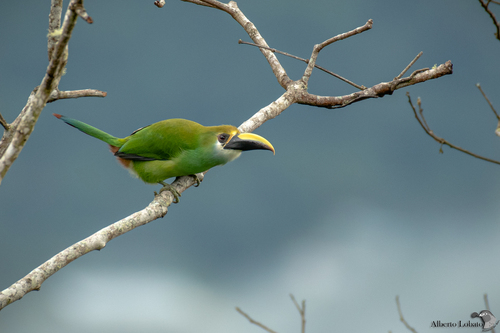
Northern Emerald-toucanet
The Northern Emerald-Toucanet ( *Aulacorhynchus prasinus*) is a vibrant, near-passerine bird belonging to the toucan family, renowned for its striking green plumage and relatively large bill. Found in the humid forests and woodlands of Mexico and Central America, this species plays a crucial role in seed dispersal, contributing to the health and diversity of its forest ecosystems. It is a popular subject for birdwatchers due to its beauty and relatively common occurrence within its range. Culturally, the toucanet, like other toucans, sometimes features in local folklore, though it is less prominent than larger toucan species.
29-37 cm
Length
Not Evaluated cm
Wingspan
Least Concern
Conservation Status
Distribution
The Northern Emerald-Toucanet is found from southern Mexico, through Belize, Guatemala, Honduras, and Nicaragua, and into northern Costa Rica. It is primarily a montane species, found at higher elevations.
Lifespan
Unknown in the wild; up to 20 years in captivity.
Northern Emerald-toucanet's Habitat
Habitat Types
Humid montane forests, Cloud forests, Forest edges, Secondary growth woodlands
Climate Zones
Subtropical, Temperate (at higher elevations)
Adaptations
Their relatively large bill, while seemingly cumbersome, is lightweight and adapted for reaching fruit on slender branches. Their zygodactyl feet (two toes forward, two backward) provide a strong grip on branches.
Variations
Several subspecies are recognized, differing subtly in plumage coloration and bill markings. These include *A. p. prasinus*, *A. p. virescens*, *A. p. volcanius*, and others, each with a somewhat restricted geographic range.
Appearance
Breeding Plumage
Little to no difference between breeding and non-breeding plumage.
Seasonal Feather Changes
Minimal seasonal variation.
Sex Based Plumage Differences
Males and females are generally similar in plumage, though males may have slightly brighter coloration in some subspecies.
Notable Features
Predominantly emerald-green body plumage., Relatively large, colorful bill, often with black, yellow, and/or chestnut markings., Blue or grey throat patch (varies by subspecies)., Reddish-brown vent and undertail coverts.
Diet and Feeding
Primary Foods
Fruits, Berries, Insects, Arthropods, Small vertebrates (occasionally)
Foraging Behavior
Primarily forages in the canopy and subcanopy, often in small groups. They pluck fruit with their bills and may also glean insects from foliage. They are known to occasionally raid nests for eggs and nestlings.
Specializations
The serrated edges of their bill help them grip and manipulate fruit. Their long tongue also assists in extracting pulp.
Seasonal Diet Variations
Diet can vary seasonally depending on fruit availability. They may consume more insects during periods when fruit is scarce.
Behavior
Social Structure
Usually found in pairs or small family groups, sometimes joining mixed-species foraging flocks.
Communication
Variety of croaking and rattling calls., Bill-clapping (possibly for communication)., Visual displays (e.g., head-bobbing)
Migration
Generally non-migratory, but may undertake some altitudinal movements in response to fruit availability.
Territorial or Group Behaviors
They are not strongly territorial, but may defend a fruiting tree from other birds.
Conservation
Threats
Habitat loss (deforestation), Habitat fragmentation, Pet trade (though less pressured than larger toucans)
Protection Programs
Protected areas within its range (e.g., national parks and reserves)., CITES Appendix II (regulating international trade).
Local National Laws
Protected under various national laws within its range.
Population Trend
Stable
Population Estimates
Not Evaluated
Interesting Facts
The Northern Emerald-Toucanet's bill is made of a lightweight, honeycombed bone structure.
This allows it to be large and strong without being overly heavy, aiding in foraging.
They are important seed dispersers for many forest trees.
By consuming fruit and excreting seeds in different locations, they help maintain forest diversity.
Unlike many birds, toucanets sleep with their tails folded over their heads.
This unusual posture may help conserve heat or provide camouflage within the tree cavity.
Faqs about Northern Emerald-toucanet
What is the difference between a toucan and a toucanet?
Toucanets are generally smaller than toucans and often have predominantly green plumage. They belong to the same family (Ramphastidae) but different genera.
Are Northern Emerald-Toucanets endangered?
No, they are currently classified as Least Concern by the IUCN. However, habitat loss remains a potential threat.
Can Northern Emerald-Toucanets be kept as pets?
While they are sometimes kept in captivity, they require specialized care, a large enclosure, and a varied diet. They are also protected under various regulations, so it's important to check local laws. Consult a professional for expert advice.
Copyright @ Nature Style Limited. All Rights Reserved.
 English
English